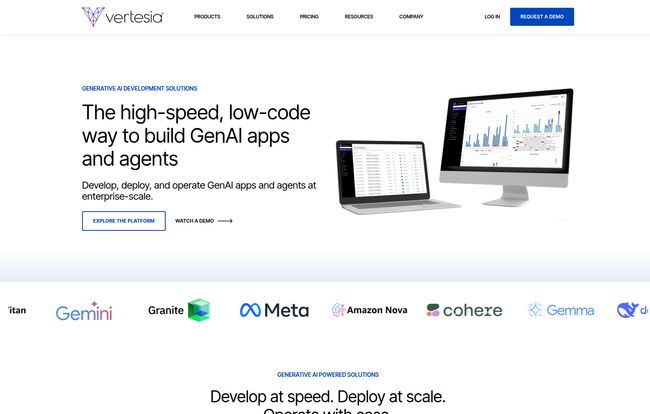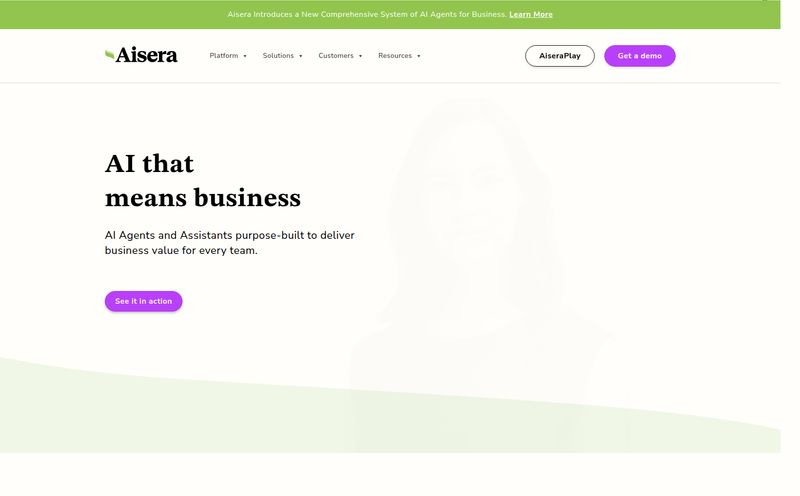The generative AI space is… crowded. Every single week there's a new “revolutionary” tool that promises to change everything. As someone who lives and breathes this stuff, I've seen more hype cycles than I can count. Most of it is just noise. But every now and then, something cuts through that noise and makes me lean in a little closer to my screen.
Lately, that something has been Vertesia.
They’re calling themselves a “high-speed, low-code GenAI toolkit,” and their whole pitch is about building and deploying real, enterprise-ready AI applications in days, not months. That’s a bold claim. Building anything enterprise-grade, especially in the wild west of AI, usually feels like trying to assemble a spaceship in the dark while the instruction manual is on fire. So, naturally, I was skeptical. But also… intrigued.

Visit Vertesia
So What Is Vertesia, Exactly?
Strip away the marketing jargon, and Vertesia is essentially a workbench for creating generative AI applications. It's a low-code platform, which is a fancy way of saying you don't need to be a grizzled, coffee-fueled coding veteran to use it. Think of it less like writing a novel from scratch and more like having a huge box of sophisticated Lego bricks. You get pre-built components for all the tricky parts—connecting to different AI models, testing, security, orchestration—and you get to focus on snapping them together to build something cool.
It's designed to sit on top of Large Language Models (LLMs) like OpenAI's GPT series, Google's Gemini, Anthropic's Claude, and others. Instead of wrangling a dozen different APIs and trying to make them talk to each other, Vertesia gives you one unified dashboard to rule them all. For anyone who's tried to build a production-level AI app, you know that managing the plumbing is half the battle. Vertesia wants to be your master plumber.
Why This Platform Has My Attention
I’ve seen a lot of AI wrappers and low-code builders, but a few things about Vertesia stand out to me. It's not just about slapping a pretty UI on an API call. There seems to be some real deep thinking about what businesses actually need to move from a cool weekend project to a full-blown, revenue-generating application.
The Low-Code Approach Actually Matters Here
For years, the promise of low-code has been to empower the “citizen developer”—the business analyst, the product manager, the marketing ops pro who knows the problem inside and out but can’t write Python. In the context of GenAI, this is huge. The people with the best ideas for AI agents and apps are often not the ones in the engineering department. Vertesia seems to get this. By making the development process visual and more intuitive, it closes that gap between idea and implementation. This means the people who feel the business pain can be the ones to build the solution. That’s how you get true innovation, not just another chatbot that tells you the weather.
Enterprise-Grade Without the Enterprise Headaches
This is where I think Vertesia could really shine. It's easy to build a demo. It’s brutally difficult to build something that can pass a security audit at a Fortune 500 company. Vertesia seems to be baking in the serious stuff from the ground up. They're talking about:
- Complete Compliance: They list things like GDPR, CCPA, HIPAA, and SOC 2. These aren't just acronyms; they are massive hurdles for any company in a regulated industry like finance or healthcare. Having a platform that’s already cleared those hurdles is a massive weight off a company's shoulders.
- Retrieval-Augmented Generation (RAG): This is a big one. RAG is how you make a generic AI model smart about your specific business. It allows the AI to pull information from your own secure knowledge bases, documents, and databases. The result? An AI that can answer questions about your company's Q3 sales data, not just the capital of France. Vertesia’s focus on an “Agentic RAG pipeline” suggests they’re taking this very seriously.
- Multi-Model Support: This is just plain smart. The best AI model today might not be the best one tomorrow. By supporting models from Google, OpenAI, Meta, Cohere, and others, Vertesia lets you future-proof your applications. You're not locked into one ecosystem. You can swap models in and out like batteries, always using the best one for the job.
Let's Talk Money: The Vertesia Pricing Structure
Alright, the part everyone wants to know about. How much does it cost? The pricing page is… interesting. And here's a little quirk I noticed: the platform is Vertesia, but the pricing page URL is `composableprompts.com`. A rebrand? A parent company? Who knows, but it's one of those little human details that makes you go 'hmm'.
They offer a few different tiers, which is pretty standard. What I really appreciate is the Free Tier. It's not just a 7-day trial; it's a legitimate free-forever plan for small projects. You get one project, one user, and up to 5,000 “runs” (think API calls) per month. This is perfect for individuals, startups, or even just for tinkering and learning the platform without whipping out the company credit card.
Once you move past the free plan, things get a bit more corporate. For the Pro, Expert, and Enterprise plans, you’ll see the dreaded “Contact Sales” button. I know, I know. I’m not a huge fan of it either. It often feels like a prelude to a high-pressure sales call. However, in the enterprise software world, it often makes sense. These plans are for complex, company-specific needs, and a one-size-fits-all price probably wouldn’t work. The pricing is likely based on usage, support levels, and custom features.
Here’s a quick breakdown of what those paid plans look like:
| Plan | Best For | Included Runs | Users |
|---|---|---|---|
| Free | Trying before you buy, small projects | 5,000 / month | 1 |
| Pro | Departmental use cases & larger teams | 50,000 | 10 |
| Expert | Organizations with sophisticated needs | 100,000 | Unlimited |
| Enterprise | The most complex enterprise programs | 200,000 | Unlimited |
One important note: Features like the Workflow and Content Engine are listed as additional costs for the Pro and Expert plans. So, make sure you ask about that during your sales call. It's always the little add-ons that get you.
The Bottom Line: Is Vertesia a Good Fit For You?
So, who is this for? After digging in, I see a few clear profiles.
If you're a startup or a small team, that Free plan is incredibly generous. It’s a no-brainer to sign up and start building. You can prove your concept and even run a small-scale live app without paying a dime.
If you're a mid-sized company or a specific department within a larger one, the Pro plan seems like the sweet spot. It gives your team the power to build and automate without needing to go through a six-month IT procurement process for every single idea.
And if you're a large enterprise, well, the Expert and Enterprise tiers are built for you. The focus on security, compliance, and scalability is exactly what your CTO wants to hear.
The main drawback, of course, is the opaque pricing for bigger plans. But the biggest advantage is speed. The promise of going from an idea to a secure, scalable production app in “days, not months” is the holy grail for so many businesses right now. If Vertesia can consistently deliver on that promise, they’re not just another tool in a crowded market; they’re a genuine game-changer.
Frequently Asked Questions about Vertesia
What makes Vertesia a 'low-code' platform?
Vertesia earns its 'low-code' title by providing a visual interface for building AI applications. Instead of writing extensive code to connect to AI models, handle security, and manage data, you use drag-and-drop components and pre-built templates. This allows people with less technical coding experience to build powerful apps.
Can I use my company's private data with Vertesia securely?
Yes, this is one of their core strengths. Vertesia is designed with enterprise-grade security in mind, mentioning compliance with standards like SOC 2 and HIPAA. Features like their Agentic RAG pipeline are specifically designed to let the AI access your proprietary data in a secure, controlled way, so the information stays within your environment.
Am I locked into using one specific AI model like GPT-4?
Not at all. Vertesia supports a wide range of models from providers like OpenAI, Google (Gemini), Meta, Anthropic and more. This multi-model support is a key feature, allowing you to choose the best model for a specific task or switch to a better, more cost-effective model as the technology advances.
What exactly is a 'run' in Vertesia's pricing?
Think of a “run” as a single, complete execution of one of your AI application's workflows. For example, a user asking a question and getting a fully-formed answer from your AI agent would constitute one run. The Free plan includes 5,000 of these per month.
Is the Free plan enough to build a real application?
Absolutely. While it has limitations (1 user, 1 project), the 5,000 runs per month are more than enough to build, test, and even run a low-traffic application or internal tool. It's an excellent way to prove your concept's value before upgrading to a paid plan.
Why do I have to contact sales for Pro and Enterprise pricing?
This is common for enterprise software. The needs of a large organization are complex and varied. The 'Contact Sales' model allows Vertesia to create a custom package based on your specific usage requirements, desired support level, need for premium features like the Workflow Engine, and the scale of your deployment. It ensures you're not paying for things you don't need.
My Final Take
In a world of over-hyped AI tools, Vertesia feels different. It feels practical. It’s not trying to be a magical black box; it’s trying to be a really, really good toolbox. By focusing on the un-sexy but critical aspects like security, compliance, and multi-model orchestration, they are addressing the real-world barriers that stop amazing AI ideas from ever seeing the light of day. I’ll be keeping a close eye on them, and if you’re looking to build something serious with generative AI, you probably should too.



